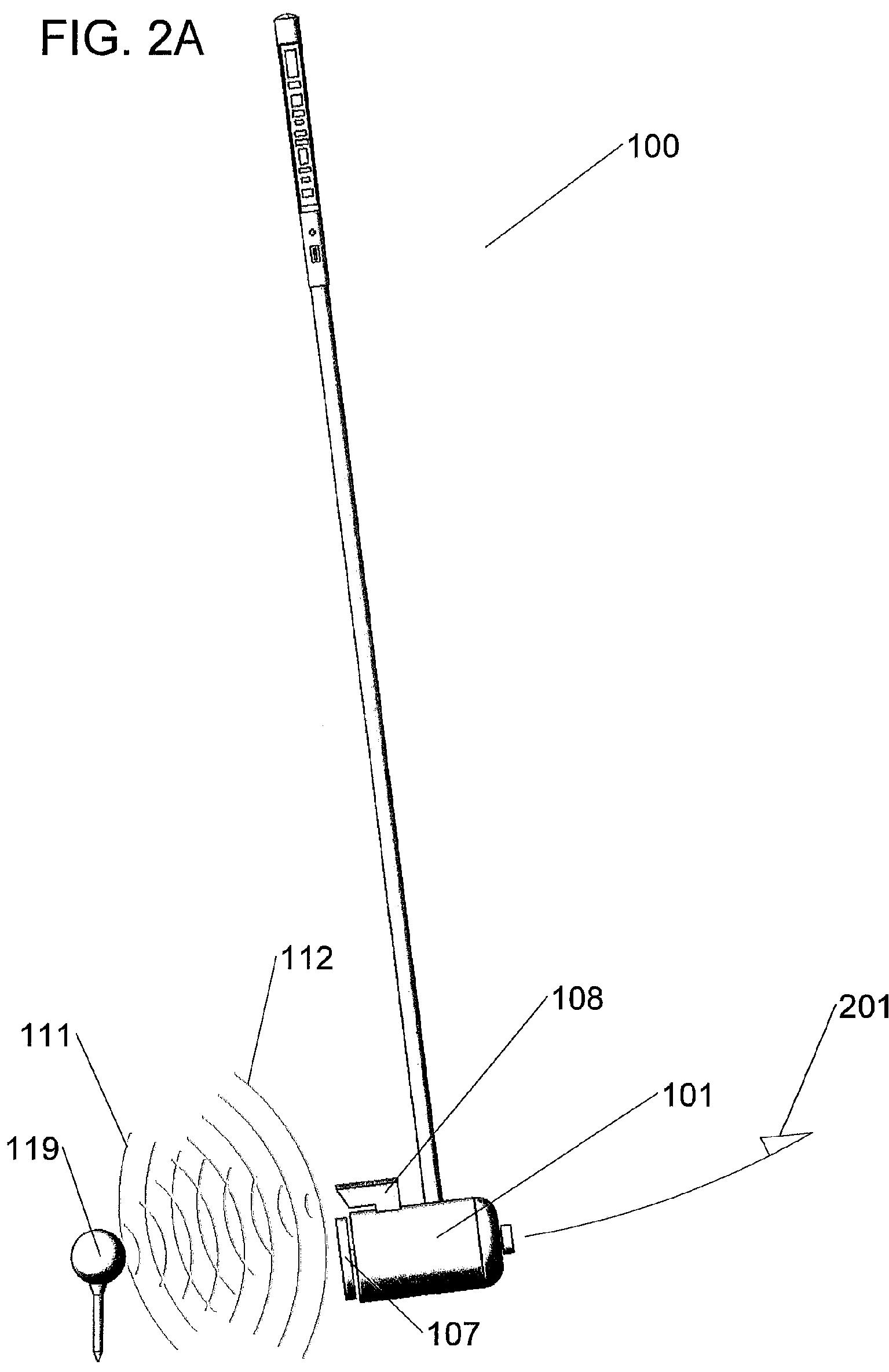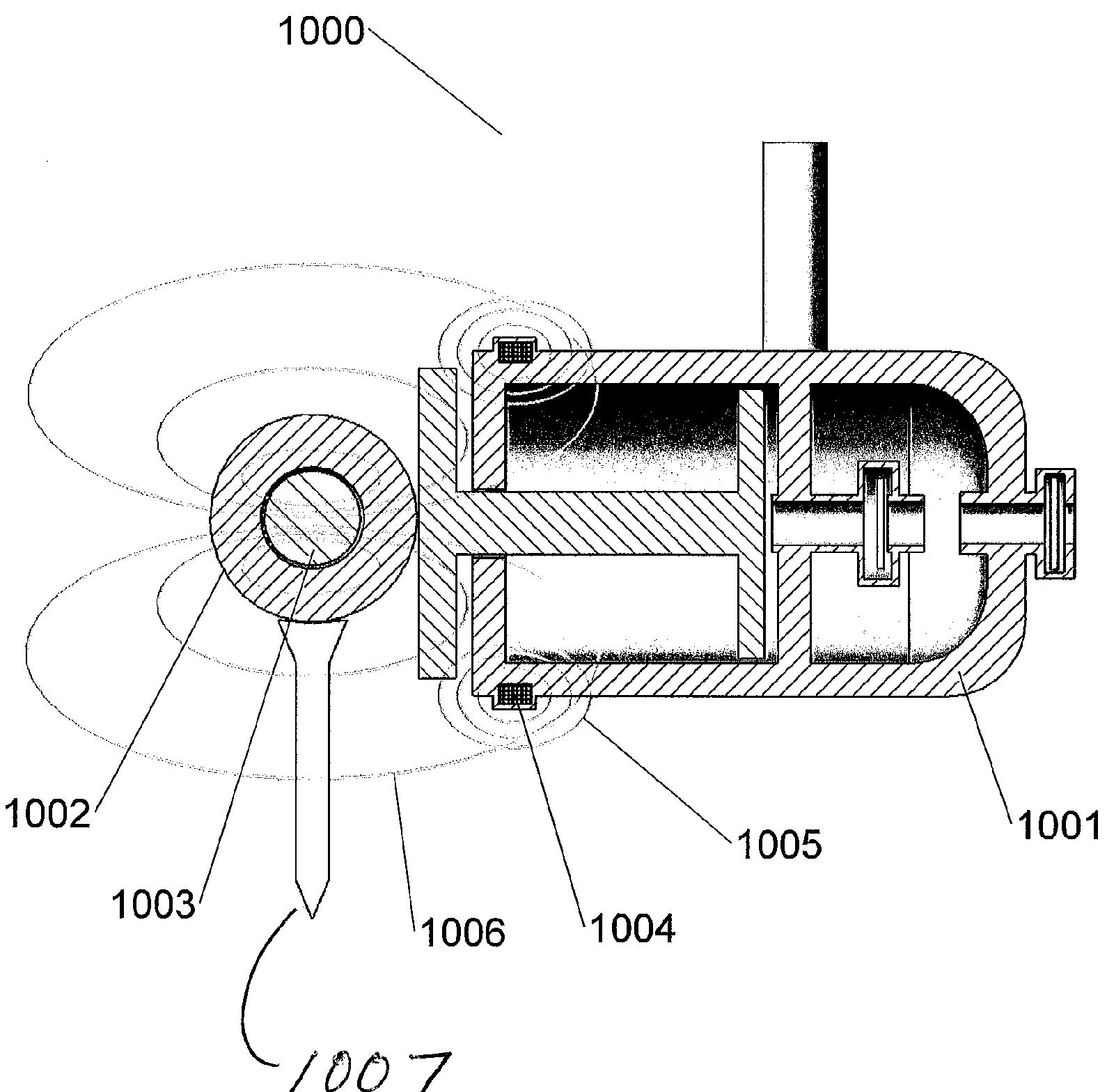Looking to Get a Little Extra Distance Out of Your Drives? Perhaps You Need an “Assistive Energy Type Golf Club”
An interesting patent application published today under the title of “Method and Apparatus for an Assistive Energy Type Golf Club” (US Pub. No. 20090029793). The application explains that getting extra distance is simply a matter of timing; or more precisely the timing of an explosive charge, the release of a compressed spring or compressed gas, or other “assistive energy” means.
The application explains:
[0010] The present invention solves the aforementioned and other problems of timing the assistive energy release for optimum golf ball velocity and distance, while still allowing a physically impaired golfer to swing the club somewhat in a manner similar to a normal golf swing.
[0011] The disclosed apparatus embodying the present invention is adapted for use with an assistive energy type golf club and includes sensing apparatus and signal processing apparatus, which together determine the optimum time to initiate the firing command prior to ball impact. This optimum time is hereinafter referred to as the pretrigger time. This pretrigger time is based on an approach parameter such as the time to ball impact, or the distance between the ball and the club head, or some other approach parameter that can be measured or determined during the swing of the golf club. Signal processing can be done a number of ways as later described by several examples.
[0012] One of the simplest exemplary embodiments of the present invention comprises a golf ball proximity sensor which senses the distance between the club face and the golf ball. The distance between the club face and the golf ball is used as the approach parameter to determine the pretrigger time. The signal processing apparatus gives the firing command when the distance between the club face and the golf ball reaches a predetermined value during the downswing.
[0013] Another apparatus embodying the present invention includes a sensor which senses the distance and the velocity of the club face toward the ball. The signal processing apparatus then predicts the time when the club face will impact the ball as the approach parameter and uses this information in combination with predetermined club characterization information to determine the optimum pretrigger time to initiate the firing command. This pretrigger time is in advance of ball impact by a delta-t time period of several milliseconds or more and is a function of several variables including the approach velocity of the club face toward the ball, the time delays inherent in the energy release sequence, the desired golf ball velocity, and others.
[0014] The present invention can be used with any assistive energy type golf club head such as an explosive charge type, a compressed spring type, compressed gas type, or others. The type of assistive energy and the design of the club head determine the inherent time delays in releasing assistive energy to add incremental velocity to the ball. Typical causes of delay times include charging an electromagnetic coil to release a firing pin, or to open a solenoid valve, hysteresis in mechanical linkages, building up pressure behind a piston, accelerating a piston up to a desired velocity prior to striking the ball, electronic signal processing delays, and others. The total sequence of events can be several milliseconds or more. These delays make an enormous difference in the resulting ball velocity and distance.
[0015] One exemplary embodiment of the invention includes sensing and signal processing apparatus to determine the club head velocity and time of ball impact. This is achieved by sensing the relative distance and associated time between the ball and club face during a downswing by using an ultrasonic type sensor. Many types of sensors can be used for this purpose including laser type, radar type, accelerometer type, metal detector type, magnetic type, contact type, light emitting diode type, and others. The details of the sensor may vary so long as it, along with signal processing apparatus, can determine the pretrigger time or pretrigger distance to give the firing command prior to ball impact.
[0016] In another exemplary embodiment, accelerometers are used to sense club motion and thereby determine club head velocity and distance to the ball and time of ball impact. In another exemplary embodiment of the invention, metal detection methods are used to sense golf ball proximity for a golf ball or tee having a metal core. In another exemplary embodiment of the invention, magnetic sensors are used to sense motion when either the ball or the tee creates a magnetic field. In another exemplary embodiment of the invention, the proximity of the ball is sensed by physical contact with a sensor positioned in front of the club face and prior to impact of the ball with the club face.
[0017] The apparatus embodying the invention can include memory storage for information such as the clubs inherent time delays, program instructions, algorithms, and information about the desired golf ball velocity or distance, the advance trigger distance and others. This information is then used to determine the optimal pretrigger time or pretrigger distance to initiate the firing command.
[0018] The signal processing apparatus can be any type of information processor such as a Texas Instrument TMS320-C2000 series type digital signal processor (DSP) or the like. Inherent delays are pre-determined by performance testing of the club. By measuring resulting ball velocity or distance as a function of club head approach velocity and trigger delta-t, data are collected, which accurately predicts the resulting golf ball velocity or distance as a function of these parameters. The desired golf ball velocity or distance could be a fixed value or alternately, a user specified value that can be input so that a specified ball velocity or distance will be achieved rather than a fixed one. Alternatively, an approximate ball velocity or distance can be achieved by giving the firing command at a pretrigger time based on a specified distance between the ball and the club head prior to ball impact as the approach parameter without taking club head approach velocity into account. Either time or distance to ball impact, or some other approach parameter can therefore be used to determine the optimum pretrigger time to give the firing command.
[0019] Either a desired resulting ball velocity or distance can be used or specified since there is a relationship between the two parameters. The distance traveled by a golf ball is dependant on its initial velocity and loft angle, and other parameters not controlled by the present invention including swing accuracy, ball rotational velocity, air density, humidity, wind and others.
[0020] Finally the method and apparatus embodying the invention further includes apparatus for initiating a firing command to begin a sequence of events leading up to assistive energy release and ball impact. This is usually in the form of an electrical signal from a digital to analog converter (DAC) that activates a trigger mechanism. An example of a trigger mechanism is an electromagnetic coil to release a firing pin toward an explosive charge detonator. Another example of a trigger mechanism is a solenoid valve to release compressed gas pressure toward a piston, etc.
Check out these drawings:
I know that the day will come when I can no longer produce my picture perfect, silky-smooth, powerful, Tiger-esque golf swing, and when that day comes I hope that these types of clubs have been perfected so that I can still g
et out and enjoy some time on the course.
Dave Dawsey – Keeping an Eye on Golf Club Inventions
PS – Someday I will give all the loyal readers of this blog a good laugh and post some videos of my swing that I captured with my ProPlay
camera. It is far from picture perfect or silky smooth.
PPS – click here to check out other driver and wood design posts


